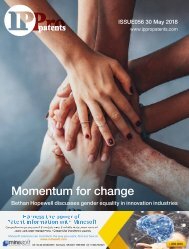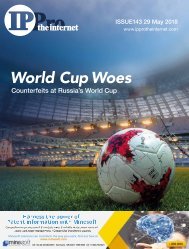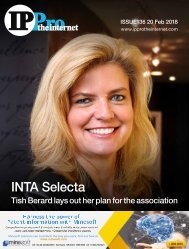IPPro Patents Issue 049
In this issue: Andrei Iancu confirmed as USPTO director
In this issue: Andrei Iancu confirmed as USPTO director
Create successful ePaper yourself
Turn your PDF publications into a flip-book with our unique Google optimized e-Paper software.
Innovation Analysis<br />
including an enhanced attorney-client relationship and satisfaction<br />
that comes from helping a client’s business grow in value.<br />
Invention and innovation are key drivers of client value<br />
Technology-based client businesses operate in highly<br />
competitive, knowledge-driven environments that are constantly<br />
changing and evolving.<br />
Accordingly, these clients must continually innovate to deliver<br />
valuable new solutions to meet customers’ evolving needs and to<br />
remain differentiated from competitors.<br />
Tech-based clients, therefore, must strive for a relatively continuous<br />
and vibrant flow of new ideas focused on serving strategic goals<br />
to not only maintain the current competitive position, but also to<br />
strategically grow revenue in new ways.<br />
Problems often go unsolved, solutions are not properly focused on<br />
the problem, solutions are not the best solution, the raw number<br />
of ideas generated by the organisation is suboptimal. For example,<br />
many organisations use brainstorming sessions to discover answers<br />
to questions that, unfortunately but predictably, continue to remain<br />
largely unanswered post-session.<br />
Most of these brainstorming sessions are uncontrolled, producing<br />
a large number of off-topic or non-feasible results, and are further<br />
contaminated by various inventive model elements that are<br />
counterproductive, thus producing suboptimal results.<br />
A purposeful innovation session can help patent counsel<br />
address some of the problems with clients’ innovation systems.<br />
The session may be executed, with patent counsel preparation<br />
and facilitation, with minimal expense, time commitment and<br />
disruption to the organisation.<br />
All tech-based businesses understand this, and many of those<br />
businesses strive for a culture of innovation, but an unfortunately<br />
large number fail to reach full innovative potential.<br />
Some of the key reasons for these innovation shortcomings include:<br />
Our experience facilitating numerous sessions is that they<br />
consistently provide both immediate and long-term value measured<br />
by: specific focus targeting; near- to mid-term commercial potential;<br />
the sheer volume of ideas generated; and training in an optimised<br />
innovation process.<br />
A general deficit of organisational knowledge of optimal<br />
inventive processes.<br />
Innovation is neither intentional nor purposeful, with invention<br />
instead occurring primarily on an ad hoc basis, with<br />
innovation becoming lost in the chaos of pressing day-to-day<br />
job responsibilities.<br />
Invention and innovation is generally expected only of technical<br />
personnel with little to no input sought from non-technical<br />
personnel, many of whom are customer-facing and may<br />
understand customer wants and needs much better than<br />
technical personnel, in some cases.<br />
A resulting inability to fully unlock and realise the full inventive<br />
potential of inventors and to effectively create a culture of<br />
creativity and innovation throughout the organisation to ensure<br />
a continuous stream of fresh ideas with maximum volume and<br />
optimised focus.<br />
How can patent counsel help correct these deficiencies? The answer<br />
is not as difficult, disruptive or time-intensive as it may seem, and<br />
patent counsel plays a leading role in the solution.<br />
The role of patent counsel as innovation stimulator<br />
Sessions executed over the years consistently produce a large<br />
volume of ideas in a very short timeframe, ranging between 50<br />
concepts to 200 concepts in a typical four to six-hour session.<br />
The following are examples from an actual session:<br />
The session was executed to improve a relatively old ‘known’<br />
portion of a medical device system. Because of the age of the<br />
related art, and the absence of new concepts, the client was<br />
pessimistic that anything of value would be produced, but<br />
nonetheless agreed to do the session.<br />
The session produced 75 potentially patentable concepts,<br />
impressive enough for a subsystem considered ‘old’. But more<br />
significantly, and of much more value to the client, 25 of the<br />
concepts were commercialisable in the short term, while 25 more<br />
concepts were commercialisable in the medium term.<br />
The client now engages in regular sessions covering various<br />
aspects of the overall system as well as exploration of new<br />
strategic directions.<br />
A successful purposeful innovation session comprises, among other<br />
things, the following key characteristics:<br />
First, the client should be introduced to the potential power of<br />
purposefully focusing on new idea generation to solve existing issues,<br />
meet customer needs, and/or explore new strategic areas.<br />
While this may sound like what the client currently expects and<br />
requires from the inventors, the actual result is almost always less<br />
than optimal.<br />
Patent counsel provides an overview of the shortcomings of the<br />
current inventive model and why it does not produce optimal<br />
results. Discussion of elements of an optimal inventive model is<br />
included with supporting research summary.<br />
Participant-inventors receive both classroom-style and<br />
experiential training that can be incorporated into daily routines,<br />
increasing invention frequency and capture.<br />
13 <strong>IPPro</strong> <strong>Patents</strong> www.ippropatents.com







